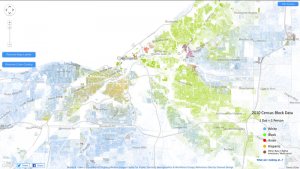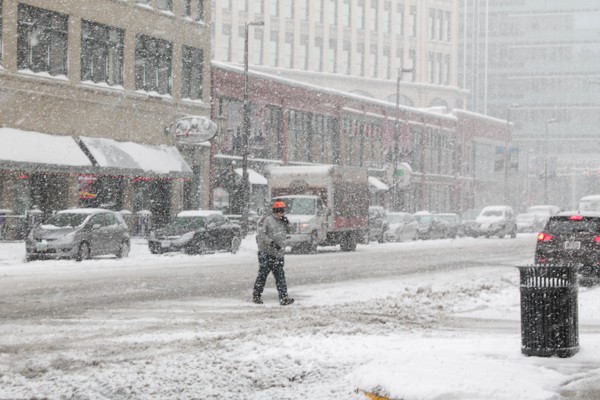
This is not a scientific study whose results were compiled by sweaty men poring over data in a dimly lit room. This is a hopefully thoughtful look at what the city can do better and even one item it can’t control. It should be noted that six months ago, the Browns undoubtedly would’ve made this list. No so today.
5.) Climate
Cleveland gets a lot of snow (9th in the country according to the NOAA) and not exactly an excess amount of sunshine. Recent studies have shown that the #1 factor in picking a new place to live within the U.S. is climate. Of course Chicago, New York, Boston, et. al receive their fair share of snow and cold as well, so weather is not a death knell. Yet, despite my optimism about curing some of Cleveland’s ills, lake effect snow might be around for a while.
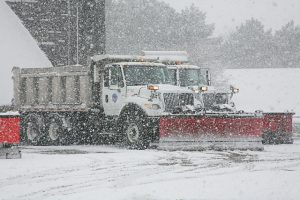
4.) Dead Man’s Curve
Somebody needs to tell me whose idea it was to put a 90-degree turn in one of the city’s major highway arteries in the busiest part of the city aka downtown? In recent years some have claimed that one of the best enticements of Cleveland, relative to other big cities, is its traffic situation. Those people apparently don’t drive from the east side of the city to the west side at 5 PM. But I digress.
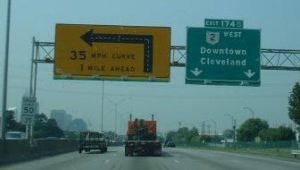
3.) Public Transportation and Heavy Rail
If you want to go some place far away, good luck taking a train from Cleveland.
But, if you’re seeking a beacon of malfeasance, shortsightedness, and mismanagement you’re in luck…there’s the RTA (Rapid Transit Authority).
In addition to massive payouts to people who don’t work for them anymore, and were marginally effective when they did, a former board president used the agency’s health insurance, without paying the monthly premiums. For years! RTA couldn’t even get a fare increase in place. And, not only because of the public’s vocal opposition , but because they couldn’t competently submit the proposal in time for the ballot.
Nearly 40 million rides were taken on RTA buses and rapid trains last year. And yes, ridership has been declining along with the region’s population, but for too many people this is their sole mode of transportation for work, for seeing family, and for other purposes and they, and the city, deserve far, far better.
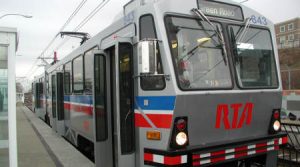
2.) Population Decline/Loss of Jobs
Though we use the moniker “Sixth City” to describe Cleveland, the city was actually once the fifth largest in America. Not so now.
Of course Cleveland is not alone in this decline. There’s a whole swath of the upper Midwest known as the Rust Belt. Of course the job losses and population decline are mutually reinforcing and for one to occur, the other must as well.
Some people would like to see this reversed. And some even have polices they’d like to see implemented. Few of them hold elected office or the reins of power unfortunately.
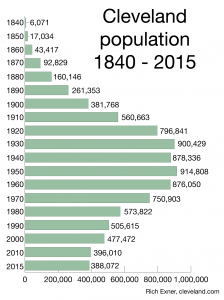
1.) A Segregated City
While it isn’t uncommon for large urban areas to have pockets of black, white, and Latino populations, any national assessment of the most segregated cities in the country will Cleveland very near the top. Some of the segregation in Cleveland is driven by nature as the Cuyahoga River creates a natural boundary between the east and west sides of the city. And certainly policies undertaken decades ago by federal agencies, formal and informal neighborhood groups, and lending institutions helped establish and perpetuate the racial and economic divisions rampant in the city.
Nevertheless this segregation continues largely unabated and Cleveland isn’t just segregated but what experts are now calling hypersegregated, meaning many racial minorities in the city aren’t just limited geographically within the city but economically as well in terms of opportunities for jobs and decent housing. This has led to what eminent scholar William Julius Wilson labeled ‘social isolation,’ or the near absolute lack of interaction between a member of the underclass and members of other classes. This type of isolation helps foment economic misfortune and helps perpetuate the cycle of poverty.
I’ve even had my own experiences with segregation here. I once took an African-American, native east-sider, to a West Park bar for the first time, she looked around at the clientele and asked simply, “And we’re in Cleveland, right?” Such was the whiteness if you will of the bustling tavern.
The segregation isn’t simply a racial issue either. Jews are heavily concentrated on Cleveland’s east side while Catholics-who make up nearly 30% of the population-are far more numerous on the west side.There is also a palpably different vibe between the east and west sides of the city, including its suburbs. This isn’t an altogether negative thing, but it certainly doesn’t lend itself to an enlightened populace. For example, there are quite a few Clevelanders for whom the idea of moving to the other side of the city is abhorrent.
If you’re wondering why segregation is such a bad thing, then you’re probably viewing the wrong website. But, to put it briefly, when you limit the opportunities, interactions, and fairness accorded to certain segments of the population, you limit the chances for well-rounded outcomes and the more people that impacts, the more it hurts the entire city.
For a deeper, first-rate analysis of the decades-long segregation quandary check out this presentation put together by ideastream and featuring some exceptional minds in the field of public policy and history.
